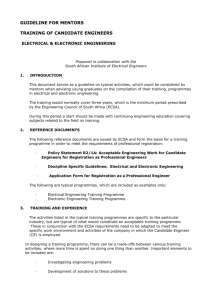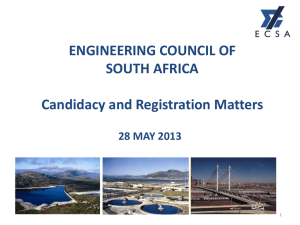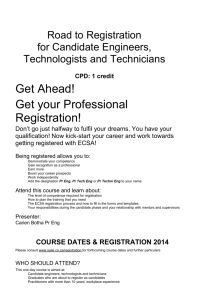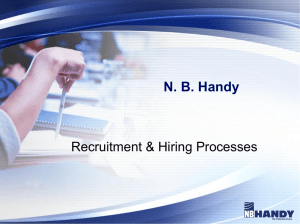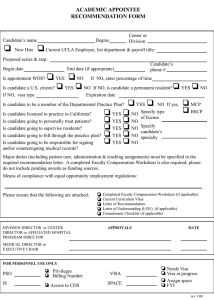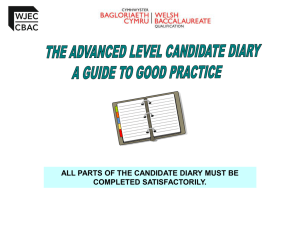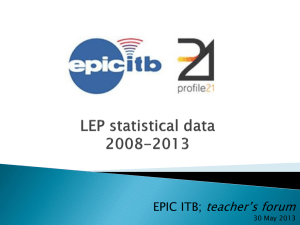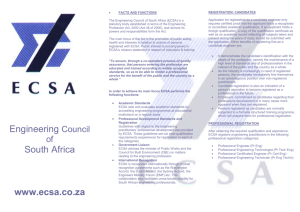Candidate
advertisement
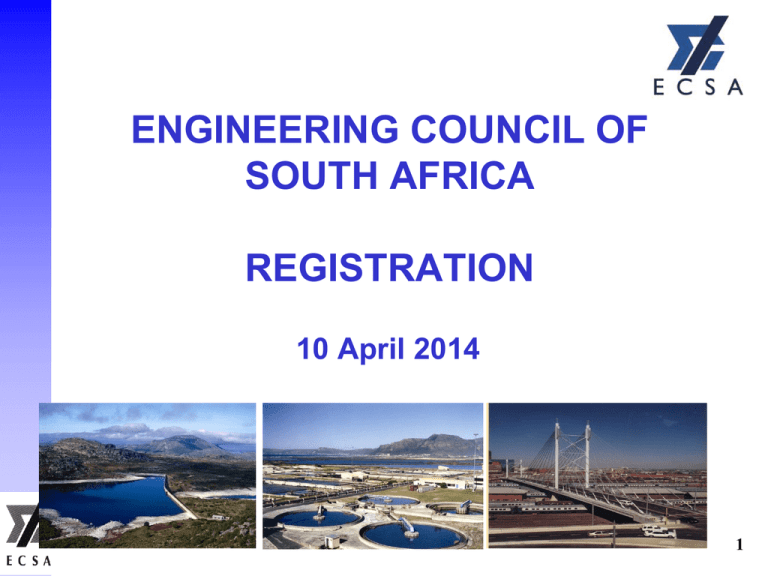
ENGINEERING COUNCIL OF SOUTH AFRICA REGISTRATION 10 April 2014 1 PROFESSIONAL REGISTRATION REQUIREMENTS Worldwide - Based on two requirements : - Academic entry level qualification( Educational standard). - Three years of practical / technical post qualification training at the appropriate Engineering level for the category of registration concerned (Experience standards for category of registration concerned). 2 PROCEDURE TO REGISTER WITH ECSA Step 1:“Candidate” Registration in order to have qualifications evaluated. o All applicants with non-accredited and non South African qualifications have to apply for “Qualification Evaluation” which is done by ECSA’s Qualification Examinations Committee(QEC). Candidate Engineer BSc(Eng)/BEng Candidate Eng Techno BTech Candidate Cert Eng Cert of Competency Candidate Eng Techni NDip 3 Professional Development Model Practice Observe Code of Conduct and Maintain Competence through CPD Professional Registration Training And Experience Meet Standard For Professional Competency Candidate Registration Graduation Accredited Programme Meet Standard for Engineering Education 4 ENGINEERING TEAM It is useful to understand the engineering team concept to explain how the different registrations work together. It must be stressed that those registered are “ different but of equal value” : Each has a vital part to play in the Engineering Team, a point emphasised by ECSA The focus and therefore the balance of the engineering team will be determined by the scope and business of the employing organisation. All contribute in some way to the creation of products, systems, procedures, and the rendering of engineering services. 5 PROFESSIONAL ENGINEER (Pr Eng) Experience standards characterised by: • Activities that are essentially intellectual • Analysing and solving complex problems • Developing and applying new technologies creatively and innovatively • Exercising Professional judgement • Managing resources • (Dreamers) 6 PROFESSIONAL ENGINEERING TECHNOLOGISTS (Pr Tech Eng) Experience standards characterised by: • Solving broadly defined problems through application of proven techniques and procedures • Developing, maintaining and managing today’s technologies • Exercising Professional judgement • Managing resources • (Doers) 7 PROFESSIONAL ENGINEERING TECHNICIAN (Pr Techni Eng) Experience standards characterised by: • Solving well defined problems using proven techniques and procedures • Supervision and technical responsibility • Contributing to implementation, operation and maintenance of products, equipment, processes and services • (Fixers) 8 OBJECTIVE OF TRAINING PROGRAMMES Training programmes must provide for the development of professional attributes and core competencies common to all CE’s regardless of the type of work undertaken or the specific direction in which their interests take them. Employer to cater for common themes, as well as specific types of work done in the organization, e.g. civil engineering - Larger employers with separate functional departments (water, geotechnical, structural, etc.) may have separately tailored training programmes for each functional department. 9 HOW AND WHEN TO REGISTER Step 2: Training and Professional Development while employed (Current system in place for the engineer and technologist categories only) Commitment and Undertaking (CU) • Employer CEO/Chief Engineer registers CU • Undertakes to train “candidate” persons in accordance with ECSA’s policy and discipline specific guidelines • Ensures internal training programme is in place and being implemented • So far 573 C&Us signed by employers of engineers countrywide and 3 773 mentors listed doing training. 10 NEW REGISTRATION SYSTEM Was implemented as from April 2013 for the Engineer category and not before October 2014 for the Technologist and Technician categories New policy guideline documents will substitute current documents. Moving towards electronic system of applying for registration during the second half of 2014. 11 New Registration Process Guideline Documents New Guideline format • R-01-P Policy on Registration of Persons in Professional Categories • R-02-PE Competency Standard for Registration as a Pr Engineer • R-03-PE Processing of Applications for Registration as Candidate Engineer and Professional Engineer • R-04-P Training and Mentoring Guide for Professional Categories • R-08-PE Guide to the Competency Standards for Registration as a Professional Engineer R-05-PE Discipline-specific Training Guidelines E-17-P Criteria and Processes for Recognition of Educational Qualifications (all professional categories) 12 Registration System Changes • Standards: moving from training focus to performance focus, e.g. – From: The work must be aimed at investigating engineering problems requiring judgement – To: Demonstrate ability to define, investigate and analyse engineering problems at a defined level against competency standards • Policies: cover all cases and fill gaps • Processes: – Define formally, including instruments used – Introduce full IT support • Guidelines: Improve understanding of requirements and transparency of process 13 TRANSITION TO NEW REGISTRATION SYSTEM The new system for the engineer category will be phased in over a period of two years, commencing as from April 2013. Candidate engineers who trained under the current (legacy) registration system will be allowed to apply in terms of the current requirements/ documentation. However, the current requirements for civil candidates of writing two essays at the professional review and mechanical candidates to hand in a design report and for electrical/electronic engineers to hand in forms AD7, AD8 and AD9, would then still apply. 14 TRANSITION PHASE continued… • The two systems would therefore be run concurrently for a period of two years to phase out all “previous system” applicants. • All applicants submitting after 1 April 2015 would therefore also have to provide New Registration System evidence of competence and will be assessed against Competency Standard R-02PE. • Alternatively, candidates who trained under the current system would have to apply in terms of the new system requirements/documentation, but they would have to supply the New Registration System evidence of competence to be assessed against competency standard R-02-PE. 15 ECSA Professional Competencies – where training must lead D 7: Meet regulatory requirements 8: Act Ethically 9: Exercise Judgement CEPLevel 2: Analyse Engineering Problems 10: Be Responsible DoR 11: Life-long Learning E 3: Synthesize Solutions 1: Use Engineering and Contextual Knowledge A C 6: Address Impacts on People and Environment 4: Manage Engineering Activities 5: Communicate Effectively B CEALevel A Outcome Group CEP = Complex Engineering Problem CEA = Complex Engineering Activity DoR = Degree of Responsibility 16 PLANNING PRINCIPLES : TRAINING PROGRAMMES Two principles must be followed by supervisors and mentors when planning training programmes for candidates : 1. A variety of work activities is necessary for the proper development of a candidate. Variety may be obtained at the various stages in the lifecycle of an engineering activity : conception, planning, design, construction, implementation, operation and closure. Associated with this lifecycle are specific functions, including commissioning, testing, improving, troubleshooting. Candidate should experience several stages in the lifecycle of a project or projects. 17 PLANNING PRINCIPLES : TRAINING PROGRAMMES (cont…) 2. Increasing responsibility and accountability within the organization must be imposed on and accepted by the candidate until he/she is capable of accepting professional responsibility in making and executing engineering decisions at the full professional level. 18 Progression throughout the candidacy period Level Nature of work: the candidate Responsibility of Candidate Level of Supervisor/Mentor Support 1. Exposure …undergoes induction, observes processes, work of competent practitioners No responsibility Mentor explains challenges and forms of solution 2. Assist …performs specific processes under close supervision Limited responsibility for work output Supervisor/Mentor coaches, offers feed back 3. Participate …performs specific processes as directed with limited supervision Full responsibility for supervised work Supervisor progressively reduces support, but monitors outputs 4. Contribute …performs specific work with detailed approval of work outputs Full responsibility to supervisor for immediate quality of work Candidate articulates own reasoning and compares it with those of supervisor 5. Perform … works in team without supervision, recommends work outputs Level of responsibility to supervisor is appropriate to a registered person Candidate takes on problem solving without support, at most limited guidance 19 PROGRESSION OF TRAINING • At each of the 5 levels of responsibility, the table shows the nature of the candidate’s work, ranging from being oriented at level A to working at the degree of responsibility required for registration, namely level E or Performing • By the end of the training period, the candidate must have performed individually and as a team member at the level of problem solving and engineering activity required for registration and performed at responsibility level E for at least twelve months. 20 REGISTRATION PROCESS • Registration process for all categories of registration basically the same and will become even more uniform when the new system is implemented. • Exception: Pr Eng category which has a compulsory professional review. • Other categories have the discretion to call applicants in for an interview 21 APPLICATION REQUIREMENTS (EXISTING SYSTEM) o Personal details (Forms A1.1 & 1.2 engineers and B.1& B.2 technologists and C.1 & C.2 technicians) o Summary of Training Periods (A2.2, B2.2 & C2.2 respectively) o Training/Experience Reports(approx 2000 words)(A 2.1, B2.1, C2.1) o Confidential Referee Reports o Project Report/Design Report o Certified copies of qualification documents (and transcripts of subjects take for technologist category) o Proof of membership of Voluntary Association (if applicable) o Application fee 22 TIPS ON EXPERIENTIAL REPORTS • SELL YOURSELF • WRITE in the FIRST PERSON • DETAIL what YOU have DONE • DETAIL YOUR level of RESPONSIBILITY • DO NOT GENERALISE • ALL PERIODS must be COVERED 23 WHY REGISTER? • Most important: Engineering Risk • Engineering activity has potentially adverse consequences and therefore must be carried out- Responsibly and ethically Economically Using available resources efficiently Safeguarding health and safety In an environment sound and sustainable way, and Managing risks throughout the entire lifecycle of a system. • Engineering is therefore a regulated profession 24 WHY REGISTER? • Peer recognition of Qualification and Experience • Professional registration = Mark of a true engineering professional • Public confidence in professional competence • International recognition • Marketability in employment market • Exclusive use of reserved names • Statutory Empowerment • Compulsory registration through work reservation Sections 18(2) and 18(3) of the Engineering Profession Act: * Prohibits a person who is not registered in a category from practicing in that category of registration; and * Permits a person registered in a category to consult in that category. * Section 26(3) of the Act prohibits a person who is not registered in terms of the Act from performing any kind of work identified for any category of registered persons. The Act in Section 26(4) allows one exception to this prohibition. * The unregistered person may work under the supervision and control of a registered person who must take the responsibility for the work. * Registered persons taking responsibility for the work of unregistered persons must do so from a fully informed position. *Must exert active supervision and control, and must approve all critical decisions. THANK YOU! Website : www.ecsa.co.za Email : engineer@ecsa.co.za Tel No : (011) 607 9500 Offices : Waterview Corner, Building 2 Ernest Oppenheimer Avenue, Bruma 28
